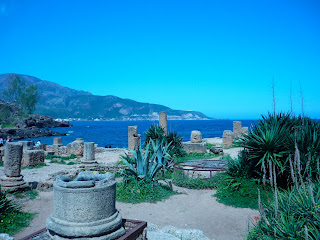My first trip outside Algiers was to Tipasa, which is a small city on the Mediterranean about an hour's drive west. It is the site of an UNESCO Heritage site, the ruins of the Roman city as well as a Byzantine church. Tipasa itself was a Phoenician (Punic) trading village, then a Roman city, then Vandal, and then Byzantine.
These few pictures are along the way to Tipasa. The first one shows the mountains to the south. The Atlas Mountains run from Morocco through Algeria to Tunisia, and in Algeria form a barrier between the fertile strip of land along the Mediterranean and the Sahara Desert.
These are two photos coming into Tipasa, with Mt. Chenoua, just under 3,000 feet high, in the background.
The next series of photos are at or around the tomb of Juba II. You can Google Juba. His father (Juba I, of course) had the distinction of being defeated by Julius Caesar shortly after Caesar left Egypt during the civil war. As a result of that loss, Juba I's son, J-II, who would have been about 6 or 7 years old at the time, was taken to Rome by Caesar and displayed in Caesar's triumphal parade. J-II had the good fortune to become friends with Caesar's great nephew Octavian, and years later when Octavian had become Emperor Caesar Augustus he installed J-II as a client king of Numidia, then Mauretania, which he ruled from what is now Cherchell, Algeria, which is on the west side of Mt. Chenoua, Tipasa being on the east side.
The royal mausoleum of Mauretania, built by J-II for he and his wife, Cleopatra Selene. By the way, similarly to J-II, Selene (daughter of Mark Antony and Cleopatra) was taken to Rome as a child after the defeat of her mother and father at Actium (city on the Ionian Sea, northern Greece, 50 or so miles from Albania) in 31BC. Augustus facilitated the marriage of Selene and J-II.
The guide said that no one was currently buried inside the mausoleum, although no one seems to know when the bodies were removed. He also said the main reason for the steel door and locks was to keep people out, not for the obvious archeological site purposes, but only because the mausoleum is in a seismic zone and the authorities didn't want anyone to be accidentally entombed as a result of an earthquake.
The tomb seems to be a popular tourist site, and many families were out on an early, nice spring day. For a small fee one could have a picture made with the camel; it was pretty popular, especially among the young boys.
The little square holes in the rocks were for connectors, since these stones were not mortared or cemented in place, but carefully hewn and placed. The dome would have been capped with a more finished material anchored with these connectors. I assume they were wood, but I don't know.
These last two photos are of crops planted along the coast. The dried cane ( I think it's cane; I didn't see any up close) I think are windbreaks and not property lines. Some fields had eight or ten sections. I wonder how long this pristine Mediterranean coastline property will be farmed; here we were about an hour west of Algiers. Except for some small villages, most of the coastline was farming, like this. I saw one new waterfront development, but it was much closer to Algiers.



















































